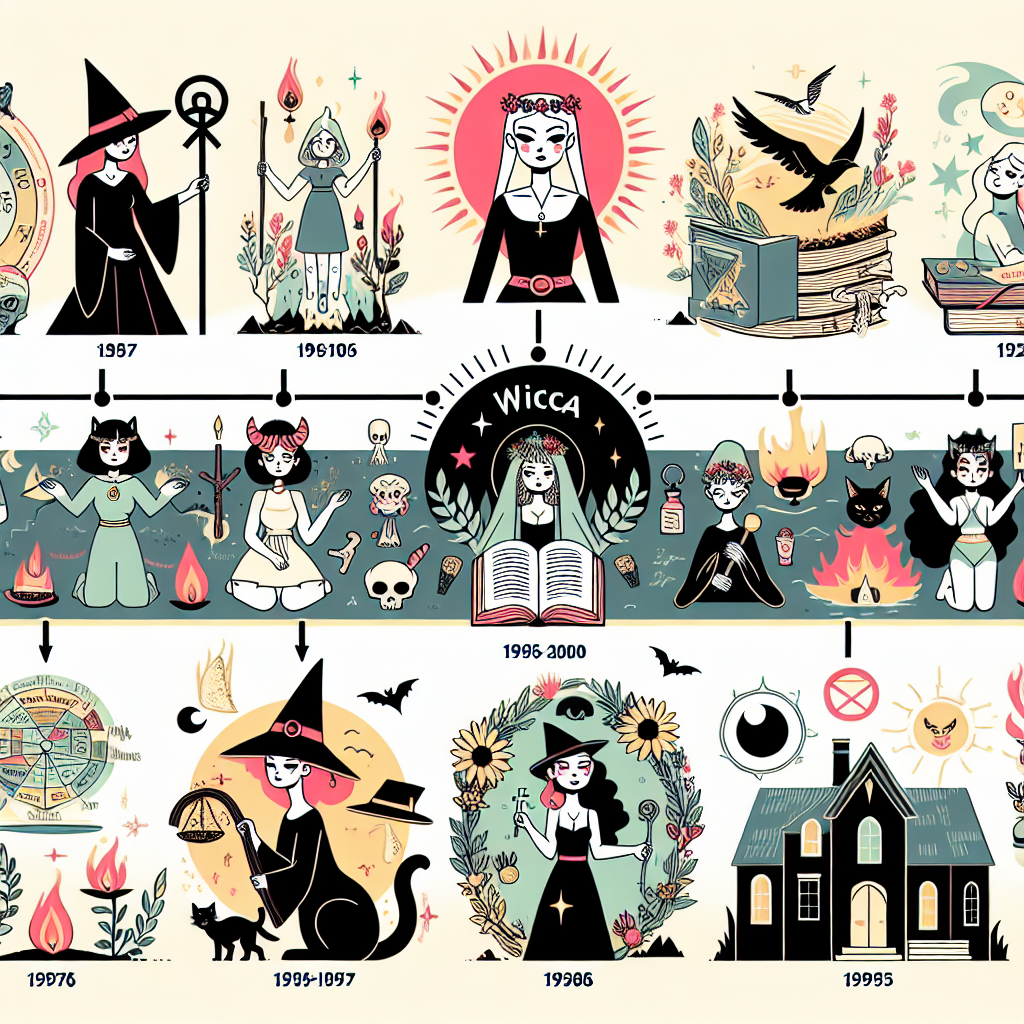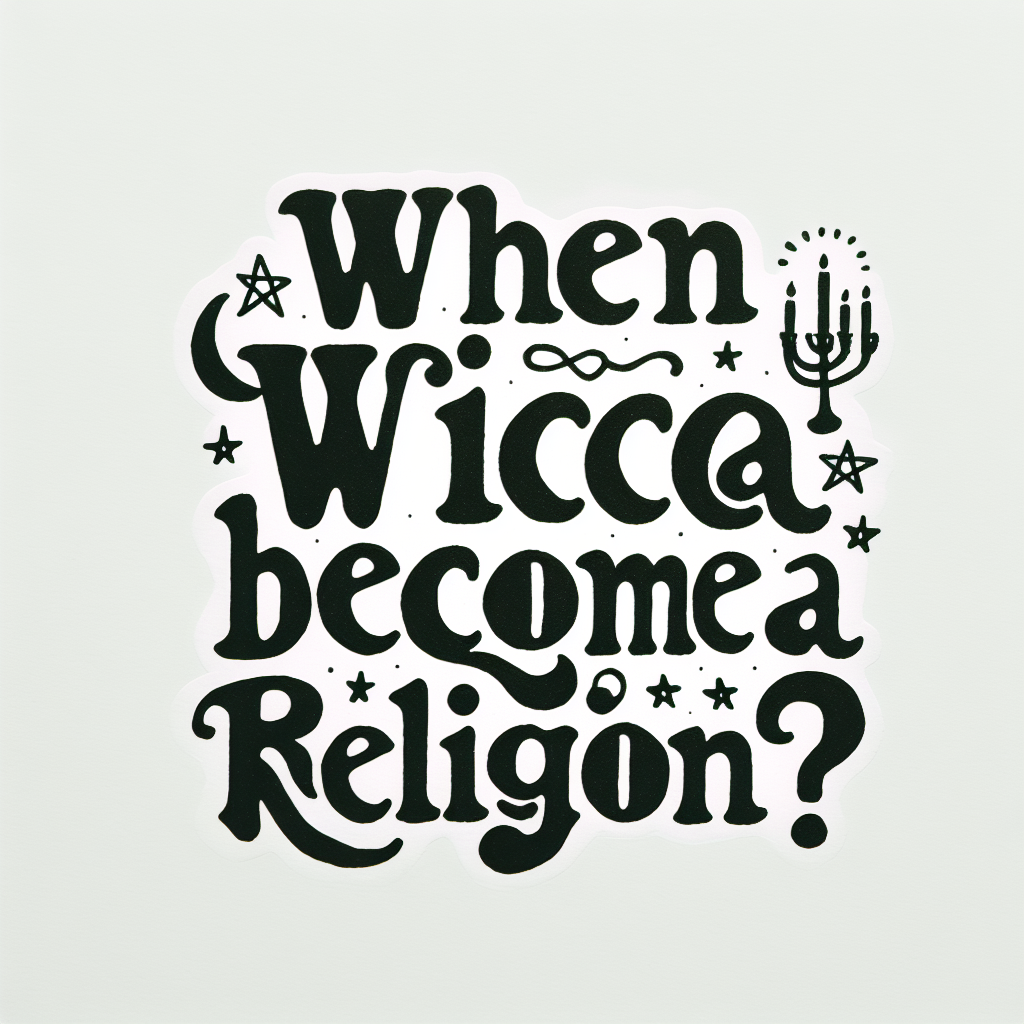As an Amazon Associate I earn from qualifying purchases.

Wicca, a modern pagan witchcraft religion, has fascinated many with its reverence for nature, ritualistic practices, and the empowerment of its adherents through mystical beliefs. Its roots can be traced back to the early 20th century, yet it significantly emerged in the public consciousness following the 1950s. Often misunderstood and shrouded in mystery, Wicca has grown from obscure beginnings to a recognized religion with a global following.
The creation of Wicca is most commonly attributed to a British civil servant and amateur anthropologist, Gerald Gardner. After the 1951 repeal of the Witchcraft Act in England, which previously criminalized witchcraft, Gardner published “Witchcraft Today” in 1954, claiming to reveal the workings of a witch cult he had been initiated into. His writings and teachings laid the foundational texts for Wicca, synthesizing various aspects of ancient pagan practices, ceremonial magic, and freemasonry lore. Thus began the spread of Wicca as a formalised spiritual path.
While Wicca’s exact numbers are hard to pin down because many practitioners opt for solitary worship away from public scrutiny, some estimates suggest that there are hundreds of thousands of Wiccans worldwide. The growth of Wicca is a testament to its flexibility and adaptability, as it allows practitioners to tailor their beliefs and rituals to personal preferences. In the United States, Wicca was recognized as an official religion in 1986 after the District Court of Virginia passed a ruling in the case of Dettmer v. Landon. This legal acknowledgement was a watershed moment, encouraging a broader social acceptance and understanding of Wicca.
The adaptability of Wicca is mirrored in its lack of centralised authority or dogmatic structures. Rather than adhering to a singular sacred text or leader, Wiccans may follow diverse paths, such as Gardnerian, Alexandrian or Dianic Wicca, each with its own specific traditions and practices. Moreover, notable days of celebration, known as Sabbats, which follow the wheel of the year, and Esbats, which are tied to lunar cycles, underline the religion’s deep connection to natural rhythms and cosmic events.
“`html
Tracing the Origins of Wicca: The Birth of a Modern Religion
“`
Wicca, commonly recognized as one of the fastest-growing modern religions, officially emerged as a new spiritual path in the mid-20th century. Developed around the 1940s and 1950s by Gerald Gardner, Wicca draws upon ancient pagan practices, hermetic traditions, and ceremonial magic. The religion gained legal recognition in countries like the UK and the USA in subsequent decades, further solidifying its status as a legitimate faith. This evolution marks Wicca’s transformation from esoteric origins to a structured belief system observed by many around the world. Join us in exploring the fascinating journey of Wicca from underground gatherings to global recognition, as we delve deeper into its rich history and foundational tenets in the next section.
When Did Wicca Become a Religion? Historical Insights
Wicca emerged as a distinct religious movement in the mid-20th century, with its roots tracing back to the early 1950s in England. The man widely credited with its foundation is Gerald Gardner, a retired British civil servant and amateur anthropologist who claimed to have been initiated into a New Forest coven in 1939. Gardner’s assertions and subsequent writings provided the basis for what would become known as Gardnerian Wicca, one of the earliest and most influential traditions within the religion.
Following the repeal of the Witchcraft Act in England in 1951, which removed penalties for the practice of witchcraft, Gardner published “Witchcraft Today” in 1954, proclaiming the existence of a contemporary witch-cult that had survived underground in Europe. Gardner’s depiction of Wicca combined elements of Western esoteric traditions, ceremonial magic, folk magic, and the writings of Margaret Murray, who claimed European witchcraft was a persecuted pagan religion. Additionally, he incorporated rituals and beliefs inspired by the teachings of Aleister Crowley and the Hermetic Order of the Golden Dawn.
The formalization of Wiccan beliefs and practices occurred throughout the 1950s and 1960s, as Gardner and his followers established covens and initiated others into the craft. With the rise of the counterculture movement in the 1960s, Wicca and other forms of modern Paganism attracted broader interest in the United States and across the Western world.
Wicca gained further legitimacy as a religion in the U.S. through a series of legal decisions. One early milestone was the 1986 United States District Court case, Dettmer v. Landon, in which the judge recognized Wicca as a religion. This signified a growing acceptance of Wicca within the American legal framework, ensuring that adherents received the same religious rights and protections as followers of other faiths.
By the 1970s and 1980s, Wicca had diversified with the emergence of different traditions, like the Alexandrian Wicca founded by Alex Sanders and the Dianic Wicca focusing on the worship of the goddess and feminist spirituality. The decentralization of authority and the eclectic nature of Wiccan practice allowed for significant growth and variation within the community. Books such as “The Spiral Dance” by Starhawk, published in 1979, and Scott Cunningham’s “Wicca: A Guide for the Solitary Practitioner” in 1988, made Wicca more accessible to the general public and facilitated the spread of solitary Wiccan practice outside the coven structure.
Today, Wicca continues to evolve and gain followers worldwide. It has become part of the larger New Age and Neopagan movements, with its rituals and practices influencing and overlapping with a wide array of spiritual paths. Wicca’s recognition as a religion is relatively recent in the grand scheme of religious history, having taken shape over the latter half of the 20th century.
As of the Pew Research Center’s 2014 Religious Landscape Study, it was estimated that 0.4% of Americans identify as Wiccan or Pagan, showcasing the growth of these faiths since their inception. This signifies a notable increase considering the obscurity of the religion at its genesis and the contemporary proliferation of its practices and adherents.
- What is Wicca, and is it considered a legitimate religion?
- When was Wicca officially recognized as a religion?
- Who is considered the founder of Wicca?
- How did Wicca evolve into an organized religion?
- Did Wicca face any legal challenges in being acknowledged as a religion?
- What role did literature and the media play in the recognition of Wicca as a religion?
- Does Wicca have a central authority or governing body?
- How diverse are the beliefs within Wicca?
- How does Wicca differentiate from other Pagan religions?
Wicca differentiates from other Pagan religions primarily through its specific ritual practices, ethical code (including the Wiccan Rede), worship of a goddess and god, and the use of ceremonial magic. While it shares a reverence for nature and pre-Christian deities with other Pagan paths, Wicca has a distinct set of teachings and practices.
- Are there any official holidays or celebrations in Wicca?
Wicca is a modern Pagan religion that draws upon a diverse set of ancient pagan beliefs, ritual practices, and hermetic traditions. It is considered a legitimate religion by many governments and organizations around the world, with practitioners entitled to the same rights and protections as followers of other religions.
Wicca was officially recognized as a religion in the United States in 1986 when the U.S. Court of Appeals for the District of Columbia Circuit affirmed its status, although it had been gaining recognition in different forms since the 1950s and 1960s.
Wicca is often attributed to Gerald Gardner, a British civil servant, who is said to have founded the religion in the late 1940s and early 1950s after publicizing and formalizing its doctrines and practices.
After Gardner’s publications in the 1950s, Wicca grew in popularity through the dissemination of his books and the establishment of covens that practiced his form of witchcraft, which began to structure and organize the beliefs into a more cohesive religion.
Yes, Wicca faced legal challenges, especially in countries where there was a strong influence of traditional monotheistic religions. Over time, legal battles were fought for the rights to practice Wicca openly and enjoy the same rights as members of other religions.
Literature and media played a critical role in the spread of Wicca, with books like Gerald Gardner’s “Witchcraft Today” bringing the religion into public awareness, and the portrayal of witches and Wiccans in media influencing public perception and interest.
No, Wicca does not have a central authority, as it is largely based on individual and coven practice. The belief system encourages autonomy and personal connection to the divine, with various traditions and strands of Wicca having their unique practices and interpretations.
Beliefs within Wicca are quite diverse, with individual practitioners and covens often having their unique interpretations of core concepts. While some commonalities exist, such as the worship of a goddess and a god, reverence for nature, and the practice of magic, Wiccan beliefs and rituals can vary significantly.
Yes, Wiccans observe eight major holidays known as Sabbats, which make up the Wheel of the Year. These include four solar festivals (the solstices and equinoxes) and four traditional Celtic festivals (Samhain, Imbolc, Beltane, and Lughnasadh). Additionally, many Wiccans celebrate full moons, known as Esbats.
Historical Insights into Wicca’s Emergence as a Religion
Wicca’s recognition as a religion can be traced back to the mid-20th century, with the pioneering work of Gerald Gardner in the 1940s and 1950s. Gardner introduced Wicca as a new religious movement by blending ancient pagan practices with modern ceremonial magic, thus founding what is often cited as the first organized form of Wicca. The publication of Gardner’s works, including “Witchcraft Today” (1954) and “The Meaning of Witchcraft” (1959), provided a coherent framework for Wicca, solidifying its growth and acceptance as a distinct religious path. The 1960s and 1970s saw a burgeoning of interest in the occult, with Wicca gaining more followers, covens, and wider social recognition particularly in the United Kingdom and the United States.
The official acknowledgment of Wicca as a religion, however, came with various legal recognitions, most notably in the United States following court cases that established its legitimacy and protected its practitioners’ rights under the First Amendment. In 1986, the District Court of Virginia affirmed Wicca’s status as a religion in Dettmer v. Landon. This watershed moment, alongside the inclusion of Wicca in the U.S. Army’s chaplain’s handbook in the 1970s, cemented Wicca’s standing as a bona fide religion in the eyes of the public and government institutions. Today, Wicca continues to evolve and grow, with a vibrant community of adherents who celebrate its eclectic roots and the ever-expanding tapestry of traditions that fall under the Wiccan umbrella.
Amazon and the Amazon logo are trademarks of Amazon.com, Inc, or its affiliates.


